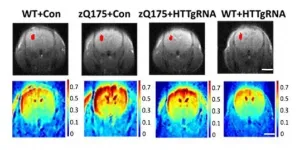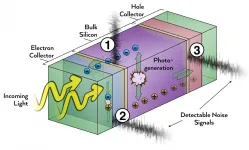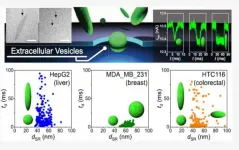New computational technique, software identifies cell types within a tumor and its microenvironment
Offers an analytical approach that has no equivalents in the current bioinformatics/systems biology toolbox
2021-07-07
(Press-News.org) (Boston)--The discovery of novel groups or categories within diseases, organisms and biological processes and their organization into hierarchical relationships are important and recurrent pursuits in biology and medicine, which may help elucidate group-specific vulnerabilities and ultimately novel therapeutic interventions.
Now a new study introduces a novel computational methodology and an associated software tool called K2Taxonomer, which support the automated discovery and annotation of molecular classifications at multiple levels of resolution from high-throughput bulk and single cell 'omics' data. The study includes a case study detailing the analysis of the transcriptome of breast tumor-infiltrating lymphocytes (white blood cells in the immune system, aka TILs) on a single-cell basis, which significantly expands upon previous findings and showcases the incorporation of the methods into an advanced in-silico (produced by computer modeling) analysis workflow.
"Our study presents a comprehensive evaluation and extensive benchmarking of the method on simulated and real data, which convincingly shows its high accuracy, its superior performance when compared to other representative methods and its capability to (re)discover known nested molecular classification," explained first author Eric Reed, PhD, a recent graduate of the BU Bioinformatics Program.
The researchers found that the K2Taxonomer-based analysis of single cell data from breast TILs characterized a transcriptional signature common to multiple immune T cell subsets. Importantly, the analysis found that activation of this signature is associated with better survival in breast cancer patients. "Our study points to some of the features of what an effective cancer immune response would look like. Not only could this enable us to better predict how breast cancer patients will fare after diagnosis, but also reveal some specific immune programs that need to be enhanced to generate a (literally) killer immune response," added corresponding author Stefano Monti, PhD, associate professor of medicine at Boston University School of Medicine (BUSM).
According to Monti, the identification and characterization of different cell types within a tumor, its microenvironment and a deeper understanding of their cross-talk, are essential to better understanding mechanisms of cancer initiation, progression and sensitivity to intervention approaches. He says the newly developed methodology can be equally applied to the analysis of other components of a tumor, including different types of malignant cells, tumor stroma (supportive tissue) and cancer-associated adipocytes (a cell specialized for the storage of fat.)
INFORMATION:
Collaborators at BUSM and BU's Henry M. Goldman School of Dental Medicine are applying the method to the analysis of single cell transcriptomics data from head and neck cancer and have identified important signaling pathways implicated in the tumor's aggressiveness and its response to targeted treatment.
K2Taxonomer is publicly available and at https://github.com/montilab/K2Taxonomer.
These findings appear online in the journal Nucleic Acids Research.
This work was supported in part by the Find the Cause Breast Cancer Foundation (https://findthecausebcf.org), the National Cancer Institute(U01 CA243004), the National Institute on Aging(NIAcooperative agreements U19-AG023122 andUH2AG064704), and the NIEHS Superfund Program (P42 ES007381).
ELSE PRESS RELEASES FROM THIS DATE:
2021-07-07
SILVER SPRING, Md.--Vaccines such as Pfizer, Moderna, Johnson & Johnson and AstraZeneca are designed to prevent severe Coronavirus-19 Disease (COVID-19) due to acute respiratory syndrome coronavirus 2 (SARS-CoV-2) and are highly efficacious. The efficacy is not different in people with and without obesity except for AstraZeneca which is not known, according to a new position statement from The Obesity Society (TOS), the leading scientific membership organization advancing the science-based understanding of the causes, consequences, prevention and treatment of obesity.
Trials have demonstrated high efficacy in individuals ...
2021-07-07
In a new study on mice, Johns Hopkins Medicine researchers report that using MRI scans to measure blood volume in the brain can serve as a noninvasive way to potentially track the progress of gene editing therapies for early-stage Huntington's disease, a neurodegenerative disorder that attacks brain cells. The researchers say that by identifying and treating the mutation known to cause Huntington's disease with this type of gene therapy, before a patient starts showing symptoms, it may slow progression of the disease.
The findings of the study were published May 27 in the journal Brain.
"What's exciting about this study is the opportunity to identify a reliable biomarker that can ...
2021-07-07
Hamilton, ON (July 7, 2021) - A McMaster University team of researchers recently discovered how, exactly, the COVID-19 vaccines that use adenovirus vectors trigger a rare but sometimes fatal blood clotting reaction called vaccine-induced immune thrombotic thrombocytopenia or VITT.
The findings will put scientists on the path of finding a way to better diagnose and treat VITT, possibly prevent it and potentially make vaccines safer.
The researchers' article was fast-tracked for publication today by the prestigious journal Nature in its accelerated article preview because of the importance of the research.
"Our work also answers important ...
2021-07-07
A genetic map of an aggressive childhood brain tumour called medulloblastoma has helped researchers identify a new generation anti-cancer drug that can be repurposed as an effective treatment for the disease.
This international collaboration, led by researchers from The University of Queensland's (UQ) Diamantina Institute and WEHI in Melbourne, could give parents hope in the fight against the most common and fatal brain cancer in children.
UQ lead researcher Dr Laura Genovesi said the team had mapped the genetics of these aggressive brain tumours for five ...
2021-07-07
Some exceptionally gifted people have marked human history and culture. Leonardo, Mozart, and Einstein are some famous examples of this phenomenon.
Is talent in a given field a uniquely human phenomenon? We do not know whether gifted bees or elephants exist, just to name a few species, but now there is evidence that talent in a specific field exists, in at least one non-human species: the dog.
A new study, just published in Scientific Reports, found that, while the vast majority of dogs struggle to learn object labels (such as the names of their toys), when tested in strictly controlled conditions, a handful of gifted word learner ...
2021-07-07
As society moves towards a renewable energy future, it's crucial that solar panels convert light into electricity as efficiently as possible. Some state-of-the-art solar cells are close to the theoretical maximum of efficiency--and physicists from the University of Utah and Helmholtz-Zentrum Berlin have figured out a way to make them even better.
In a new study, physicists used a technique known as cross-correlation noise spectroscopy to measure miniscule fluctuations in electrical current flowing between materials inside silicon solar cells. The researchers identified crucial electrical ...
2021-07-07
Nature has a vast store of medicinal substances. "Over 50 percent of all drugs today are inspired by nature," says Gisbert Schneider, Professor of Computer-Assisted Drug Design at ETH Zurich. Nevertheless, he is convinced that we have tapped only a fraction of the potential of natural products. Together with his team, he has successfully demonstrated how artificial intelligence (AI) methods can be used in a targeted manner to find new pharmaceutical applications for natural products. Furthermore, AI methods are capable of helping to find alternatives to these compounds that have the same effect but are much easier and therefore cheaper to ...
2021-07-07
Researchers at the IBS Center for Quantum Nanoscience at Ewha Womans University (QNS) have shown that dysprosium atoms resting on a thin insulating layer of magnesium oxide have magnetic stability over days. In a study published in Nature Communications they have proven that these tiny magnets have extreme robustness against fluctuations in magnetic field and temperature and will flip only when they are bombarded with high energy electrons through the STM-tip.
Using these ultra-stable and yet switchable single-atom magnets, the team has shown atomic-scale control of the magnetic field within ...
2021-07-07
Dr Bock, under the mentorship of Distinguished Professor Dietmar Hutmacher, from QUT Centre for Biomedical Technologies, has focused her research on bone metastases from breast and prostate cancers.
She developed 3D miniature bone-like tissue models in which 3D printed biomimetic scaffolds are seeded with patient-derived bone cells and tumour cells to be used as clinical and preclinical drug testing tools.
The research team investigated their hypothesis that traditional anti-androgen therapy had limited effect in the microenvironment of prostate cancer bone tumours. The team's findings are published in Science Advances.
"We wanted to see if the therapy could be a contributor of cancer cells' adaptive responses that fuelled bone ...
2021-07-07
A recent study by scientists from Japanese universities has shown that the shape of cell-derived nanoparticles, known as "extracellular vesicles" (EVs), in body fluids could be a biomarker for identifying types of cancer. In the study, the scientists successfully measured the shape distributions of EVs derived from liver, breast, and colorectal cancer cells, showing that the shape distributions differ from one another. The findings were recently published in the journal Analytical Chemistry.
Early detection of cancerous tumors in the body is essential for ...
LAST 30 PRESS RELEASES:
[Press-News.org] New computational technique, software identifies cell types within a tumor and its microenvironment
Offers an analytical approach that has no equivalents in the current bioinformatics/systems biology toolbox






